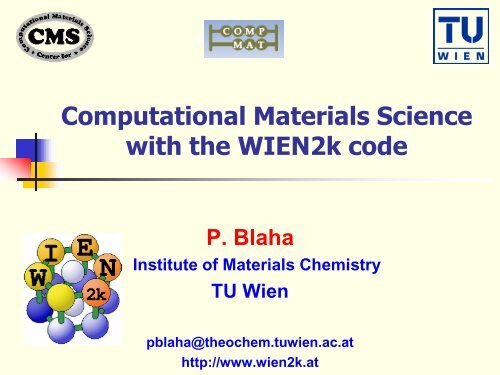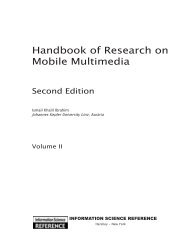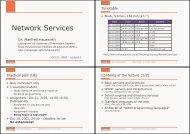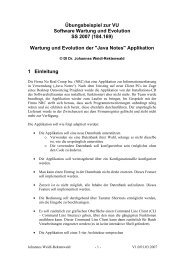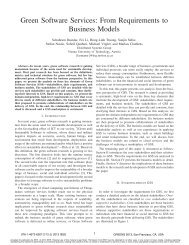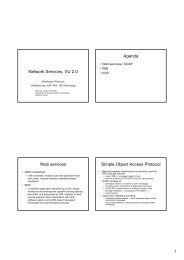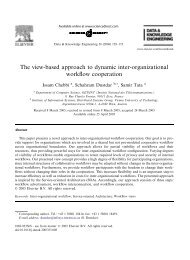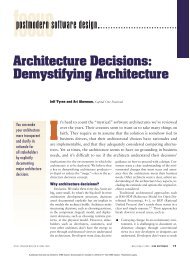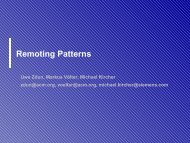Computational Materials Science with the WIEN2k code
Computational Materials Science with the WIEN2k code
Computational Materials Science with the WIEN2k code
Create successful ePaper yourself
Turn your PDF publications into a flip-book with our unique Google optimized e-Paper software.
<strong>Computational</strong> <strong>Materials</strong> <strong>Science</strong><br />
<strong>with</strong> <strong>the</strong> <strong>WIEN2k</strong> <strong>code</strong><br />
P. Blaha<br />
Institute of <strong>Materials</strong> Chemistry<br />
TU Wien<br />
pblaha@<strong>the</strong>ochem.tuwien.ac.at<br />
http://www.wien2k.at
<strong>Computational</strong> <strong>Materials</strong> <strong>Science</strong><br />
• describe materials by quantummechanical simulations(ab initio)<br />
• simulate:<br />
• infinite (“perfect”) bulk solids<br />
• impurities, vacancies in solids<br />
• surfaces<br />
• nanostructures<br />
• atomic and electronic structure<br />
• stability, phase transitions, mechanical properties, …<br />
• magnetism, chemical bonding, ….<br />
• spectroscopies (IR, Raman, XPS, XAS, XES, EELS,Mössbauer, NMR, STM)
Method: DFT calculations<br />
• numerical solution of a Schrödinger-like equation (Kohn-Sham)<br />
<br />
k k k<br />
<br />
V<br />
( r)<br />
<br />
i<br />
ei<br />
i<br />
2 <br />
• expansion into “augmented plane waves” basisfunctions f Kn :<br />
<br />
• variational principle<br />
1 2 k = Ck<br />
f<br />
n<br />
K<br />
k<br />
n<br />
< E<br />
n<br />
n…50-100 APWs / atom<br />
< | H | > < E<br />
>=<br />
< | > C<br />
k n<br />
><br />
=0<br />
• generalized eigenvalue problem<br />
H C=E S C<br />
• Setup and diagonalization of (real or complex) matrices of<br />
size 10.000 to 50.000 (up to 50 Gb memory, only 10% of e i )
Loops:<br />
• loop 1: different structures (atomic positions)<br />
• loop 2: scf-cycle (solve [-½ 2 +V]=E new V iterate)<br />
• loop 3: k-loop (solve H =E for different k-points)<br />
• loop 4: setup + diagonalization of H C = E S C<br />
• largest effort, highest optimization, best parallelization,<br />
• “scaling of time and memory”<br />
• F90, mpi, Scalapack, blas<br />
1<br />
4<br />
2<br />
5<br />
3<br />
6<br />
processors<br />
• loop over APWs<br />
7 8 9<br />
• in parallel (via scripts, “slow” network, common NFS)<br />
10000-50000<br />
• sequential (efficient multi-secant BROYDEN-mixing; L.Marks PRB 78, 075114)<br />
• coarse grain parallel (different jobs) or sequential (forces new positions)
<strong>WIEN2k</strong> software package<br />
An Augmented Plane Wave Plus<br />
Local Orbital<br />
Program for Calculating Crystal<br />
Properties<br />
Peter Blaha<br />
Karlheinz Schwarz<br />
Georg Madsen<br />
Dieter Kvasnicka<br />
Joachim Luitz<br />
November 2001<br />
Vienna, AUSTRIA<br />
Vienna University of Technology<br />
http://www.wien2k.at<br />
developed over more than<br />
25 years<br />
1400 registered groups<br />
2000 mailinglist users<br />
Europe: A, B, CH, CZ, D, DK, ES, F, FIN, GR, H, I, IL, IRE, N, NL,<br />
PL, RO, S, SK, SL, SI, UK, ETH Zürich, MPI Stuttgart, FHI Berlin,<br />
DESY, TH Aachen, ESRF, Prague, IJS Ljubjlana, Paris, Chalmers,<br />
Cambridge, Oxford<br />
America: ARG, BZ, CDN, MX, USA (MIT, NIST, Berkeley, Princeton,<br />
Harvard, Argonne NL, Los Alamos NL, Oak Ridge NL, Penn State,<br />
Purdue, Georgia Tech, Lehigh, John Hopkins, Chicago, Stony<br />
Brook, SUNY, UC St.Barbara, UCLA)<br />
far east: AUS, China, India, JPN, Korea, Pakistan,<br />
Singapore,Taiwan (Beijing, Tokyo, Osaka, Kyoto, Sendai, Tsukuba,<br />
Hong Kong)<br />
55 industries (Canon, Eastman, Exxon, Fuji, Hitachi, IBM,<br />
Idemitsu Petrochem., Kansai, Komatsu, Konica-Minolta, A.D.Little,<br />
Mitsubishi, Mitsui Mining, Motorola, NEC, Nippon Steel, Norsk<br />
Hydro, Osram, Panasonic, Samsung, Seiko Epson, Siemens, Sony,<br />
Sumitomo,TDK,Toyota).
w2web GUI (graphical user interface)<br />
• Structure generator<br />
• spacegroup selection<br />
• import cif file<br />
• step by step initialization<br />
• symmetry detection<br />
• automatic input generation<br />
• SCF calculations<br />
• Magnetism (spin-polarization)<br />
• Spin-orbit coupling<br />
• Forces (automatic geometry<br />
optimization)<br />
• Guided Tasks<br />
• Energy band structure<br />
• DOS<br />
• Electron density<br />
• X-ray spectra<br />
• Optics<br />
• command line possible !
current hardware:<br />
•SFB Aurora<br />
• IBM Cluster<br />
• 72 x Dual Xeon<br />
3.6 GHz, 1MB L2<br />
• Infiniband Switch<br />
• (installed 2005)<br />
• SUN Cluster<br />
• 72 x Quad-Opterons<br />
2.4 GHz<br />
• Infiniband Switch<br />
• (installed 2006)<br />
• <strong>WIEN2k</strong> on IBM-BlueGene<br />
(2000 processors)
Timing and parallel performance:<br />
Task<br />
Time (s)<br />
r, V eff 151<br />
H, S setup 1176<br />
full diagonalization 2454<br />
iterative diag. 461<br />
3x3 super-cell of a h-BN/Ni(111)<br />
surface model <strong>with</strong> 99 atoms/cell<br />
(N bas = 16900, 1 scf-cycle on 4 cores)<br />
iterative block-Davidson diagonalization<br />
<strong>with</strong> improved preconditioner<br />
[formally H -1 instead of diag(H-eS) -1 ; but<br />
only factorization of H required]<br />
hand-<strong>code</strong>d mpi (setup)<br />
scalapack (diagonalization)<br />
(limitations due to stacked<br />
Infiniband switch)
h-BN / Rh(111) nanomesh<br />
STM Experiment: M.Corso et al., <strong>Science</strong> 303, 217(2004)<br />
“partial double layer model”<br />
Theory: R.Laskowski et al., PRL 98, 106802 (2007):<br />
“Corrugated single layer model”<br />
12x12 Rh, 13x13 BN, 1108 atoms/cell,<br />
HC=ESC (50000x50000, 50 GB memory)<br />
64 cpus, 2h/scf-cycle (was 20h!!)<br />
3 month of computing time<br />
N corrugation<br />
Theoretical model was confirmed later !<br />
H. Dill, et. al.: <strong>Science</strong> 319, S. 1824(2008)
Thank you for<br />
your attention !


